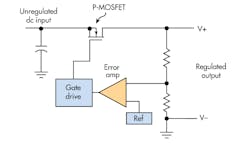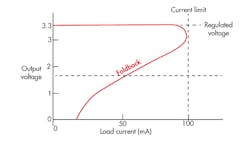LDOs Bring High Efficiency and Low Noise Regulation to Industrial Automation
Download this article in PDF format.
Designing a power-supply system for industrial automation equipment requires a thorough understanding of the surroundings and conditions that affect the functionality of the wide range of equipment involved. The most important design decision is whether to use linear power supplies or switch-mode power supplies (SMPS).
Today, SMPS are the most popular because of their high efficiency. However, they do have downsides that make linear supplies more desirable. Linear supplies also have their disadvantages, but often turn out to be the best choice for industrial use. Even better is a “have your cake and eat it too” solution: Use a linear supply with low-dropout (LDO) regulators.
Linear vs. SMPS
As mentioned, the primary reason for using switch-mode supplies is their high efficiency. Typical figures vary with the application, but efficiencies of greater than 90% are typical. High efficiency translates into minimum power loss in the supply with its attendant low heat dissipation. In large complex industrial settings with lots of equipment efficiency, power usage and heat dissipation become critical factors in terms of operating costs.
The main disadvantage of the SMPS is its noise generation. High-frequency pulse-width-modulated (PWM) pulses are filtered to form the desired dc level, but the resulting ripple and radiated or conducted noise generated can negatively impact the powered equipment and nearby devices.
Linear supplies with linear regulators don’t have the noise problem. Furthermore, ripple is greatly reduced by large capacitive filters and the feedback action of the regulator circuitry.
1. Often, a traditional linear IC regulator architecture will use a Darlington bipolar series pass transistor.
The big issue with these supplies, though, is that the efficiency is very poor (Fig. 1). A series pass transistor between the dc input voltage and the regulated dc output requires a minimum amount of voltage drop in order to maintain regulation. This voltage, called the dropout or headroom voltage, is usually a minimum of 1.5 to 2.5 V or more.
Since the output current passes through the pass transistor, this device will dissipate a significant amount of power, all of which shows up as heat. As the input or output voltages vary, the feedback senses the change and drives the pass transistor to adjust its conductance to compensate from any variation. This linear operation requires the minimum overhead be observed to maintain regulation. The overall benefit is no noise generation traded off for efficiency.
One way to get the benefits of low noise and good efficiency concurrently is to use a LDO regulator.
LDO Operation and Benefits
One definition of LDO is a regulator that operates with a series-pass-transistor voltage drop of less than 1 V. A dropout voltage of 1 V or more defines a conventional linear regulator.
A dropout of less than 1 V can be achieved with a PNP bipolar series pass transistor, but modern designs generally use a P-type MOSFET with very low dropout voltages of less than 100 mV (in addition to low on-resistance) (Fig. 2). When working with low supply voltages of 3.3 V or less, low dropout levels become a significant percentage of the output, so less is more.
2. Here’s a typical IC LDO circuit with a P-type MOSFET pass transistor.
The regulation process is similar to other series regulators in that any output voltage change is sensed and the gate drive to the MOSFET is varied to correct for the variation.
Key benefits of an LDO include:
- Low noise and ripple: There are no switching transients. Ripple is greatly reduced by the feedback regulatory action, thus providing an excellent power-supply rejection ratio (PSRR).
- Low quiescent current: Minimal operational current makes LDOs a good choice for battery-operated devices.
- Small packages: Most housings are tiny and no external inductors are required.
- Wide input-voltage range: This accommodates large input transient voltages without protection or damage.
- Good transient response: Adapts rapidly to fast load changes.
The LDO is often used to power processors and field-programmable gate arrays (FPGAs) that require the fast transient response. And they’re ideal for critical linear circuits like signal-conditioning amplifiers, oscillators, and PLL synthesizers. In industrial-automation applications, LDOs make good regulators for sensors, data converters, and wireless/communications/networking circuits.
The Current-Limiting Issue
Some applications put excessive stress on power supplies, especially in industrial automation. High temperature and high voltages are very common. Another potential problem is excessive current draw or a short circuit. Sudden high current flow will typically damage the regulator unless it’s compensated for. That problem can be handled by incorporating LDOs with internal overcurrent protection.
Two basic types of current limiting are used in LDOs: brick wall and foldback. In the brick-wall method, a current limit is set and if that limit is exceeded, the LDO abruptly shuts down. The regulator continues to supply current at the cutoff level, but the output voltage is no longer regulated. The output voltage becomes the product of the current-limit value and the load resistance. The series pass transistor will continue to dissipate power until the internal protection process of thermal shutdown turns off the device.
The foldback method of current limiting attempts to keep total power dissipation at a constant level. If overcurrent conditions occur, the circuitry reduces the output current and there’s a decrease in output voltage (Fig. 3). This keeps the power dissipation within the capability of the device. After that, thermal protection kicks in if elevated temperature conditions persist.
3. Looking at a comparison of output voltage vs. load current, it shows that foldback reduces the output voltage as output current exceeds the limit of the device.
Different LDOs use different methods of current limiting, so you should choose one that fits your application. For example, Texas Instruments offers the TPS7A16 LDO with brick-wall current limiting and the TLV71P LDO with foldback current limiting. More details on current limiting can be found at this reference.
Thermal Issues
While LDOs are more efficient than standard linear regulators, they still dissipate power. Most LDOs also include thermal-shutdown circuitry, which turns off the device if the temperature exceeds the limit—usually in the 150-170º range. In some applications, a heat sink may be needed.
In addition, careful attention should be given to the thermal conditions in the power supply. Besides the thermal specifications of the IC itself, you should consider other factors such as PCB design and component placement in regards to the interaction with other devices. The greater the copper area devoted to the LDO, the better the heat dissipation. Other factors to consider are ambient temperature and airflow ventilation.
You can learn more about thermal considerations from videos that shows you how to measure thermal properties and how to avoid damaging an LDO through thermal excess. This and other LDO videos are available from Texas Instruments.
About the Author

Lou Frenzel
Technical Contributing Editor
Lou Frenzel is a Contributing Technology Editor for Electronic Design Magazine where he writes articles and the blog Communique and other online material on the wireless, networking, and communications sectors. Lou interviews executives and engineers, attends conferences, and researches multiple areas. Lou has been writing in some capacity for ED since 2000.
Lou has 25+ years experience in the electronics industry as an engineer and manager. He has held VP level positions with Heathkit, McGraw Hill, and has 9 years of college teaching experience. Lou holds a bachelor’s degree from the University of Houston and a master’s degree from the University of Maryland. He is author of 28 books on computer and electronic subjects and lives in Bulverde, TX with his wife Joan. His website is www.loufrenzel.com.



